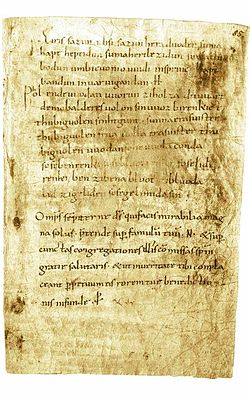User:Varoon Arya/Merseburg Incantations

The Merseburg Incantations (German: die Merseburger Zaubersprüche) are two Old High German magic incantations or charms recorded in a theological manuscript from Fulda dating to the 9th century.[1] These short metrical works are commonly considered to be the only known texts which record continental Germanic pagan beliefs in Old High German.[2] They were discovered by Georg Waitz in the library of the Merseburg Cathedral in 1841 and published for the first time by Jacob Grimm in 1842.[3]
Date
[edit]Grimm (1865), arguing from the morphological features of key terms in the texts, was first to suggest that the Merseburg Incantations were probably composed long before they were recorded in the 10th century, perhaps as much as two or three centuries.[4] The date of composition has since been narrowed down to the middle of the 8th century.[5]
Language
[edit]The language of the Incantations is commonly listed as Old High German. Grimm (1865), after a detailed examination of the texts, concludes that the language is neither pure Old High German, nor Old Saxon, but rather something between these two, possibly Thuringian in origin.[6] Thomas (1909) considers the language to be Frankish.[7]
Form
[edit]Like most medieval German charms, the Merseburg Incantations are each composed of two parts: an epic historiola, which narrates a mythological precedent for the action which is to be affected, and an incantation proper.[8] DuBois (1999) proposes that the purpose of the historiola is to remind the addressee of his or her benevolence and/or past success and to thereby persuade the addressee towards a similar action in the present, while the incantation proper may be a repetition of words believed to have been spoken by the addressee during such an act.[9]
First Merseburg Incantation
[edit]Text and translation
[edit]|
OHG Original[10] |
German Translation[11] |
English Translation[12] |
Latin Translation[13] |
Interpretation
[edit]Most critics agree that the purpose of the First Merseburg Incantation was to cause the release of bound captives.[14] Wantanabe-O'Kelly (1997) argues that it is more likely an allegory for paralysis or cramp, a position which Schutz (2004) also considers as possible.[15] Edwards (1994) thinks the charm could have come from the sphere of midwifery, noting the similarity between the imagery of 'loosing' in the First Merseburg Incantation and several Latin charms which were used to ease the process of childbirth.[16]
Schutz (2004), interpreting idisi as 'valkyries', believes the charm to was intended to conjure valkyries to affect the escape.[17]
Notes
[edit]- ^ The document which contains the charms, a church missal listed as Codex 136, was produced in the 9th century, though the charms themselves were copied onto a blank page (f. 84r; 85r in the old numbering) of that document sometime in the middle of the 10th century. Cf. Schutz (2004:193); Wantanabe-O'Kelly (1997:12).
- ^ Bostock (1976:26)
- ^ Jeep (2001:112).
- ^ Grimm (1865:20).
- ^ Skemer (2006:43) suggests ca. 750.
- ^ Grimm (1865:20-21).
- ^ Thomas (1909:5).
- ^ Jeep (2001:112). Cf. also Bostock (1976:26-27).
- ^ DuBois (1999:108).
- ^ Jeep (2001:112).
- ^ Thomas (1909:5)
- ^ Jeep (2001:112).
- ^ Grimm (1865:4)
- ^ Jeep (2001:112).
- ^ Wantanabe-O'Kelly (1997:13); Schutz (2004:194).
- ^ Edwards (1994:167-168).
- ^ Schutz (2004:193-194).
References
[edit]- Bostock, J. Knight (1976). A Handbook on Old High German Literature. Oxford: Oxford University Press. ISBN 0-19-815392-9.
- DuBois, Thomas A. (1999). Nordic Religions in the Viking Age. Philadelphia: University of Pennsylvania Press. ISBN 0-8122-3511-8.
- Edwards, Cyril (1994), "German Vernacular Literature: A Survey", in McKitterick, Rosamond (ed.), Carolingian Culture: Emulation and Innovation, Cambridge: Cambridge University Press, ISBN 0-521-40524-6
- Grimm, Jacob (1865). Kleinere Schriften, Bd. II: Abhandlungen zur Mythologie und Sittenkunde. Berlin: Ferd. Dümmlers Verlagsbuchhandlung.
- (Ed.) Jeep, John M. (2001). Medieval German: An Encyclopedia. New York: Garland Publishing. ISBN 0-8240-7644-3.
{{cite book}}:|last=has generic name (help)
- Schutz, Herbert (2004). The Carolingians in Central Europe, their History, Arts and Architecture: A Cultural History of Central Europe, 750-900. Leiden: Koninklijke Brill NV. ISBN 90-04-13149-3.
- Thomas, Calvin (1909). An Anthology of German Literature. Boston: D.C. Heath & Co., Publishers.
- (Ed.) Wantanabe-O'Kelly, Helen (1997). The Cambridge History of German Literature. Cambridge: Cambridge University Press. ISBN 0-521-43417-3.
{{cite book}}:|last=has generic name (help)
